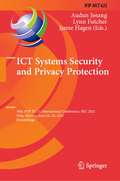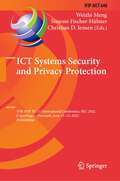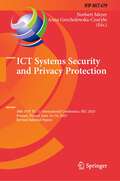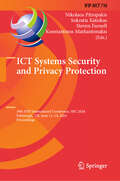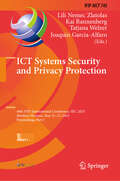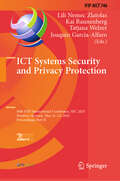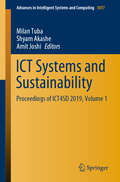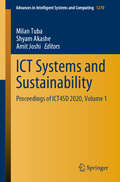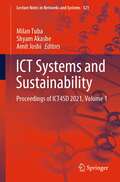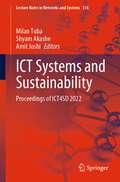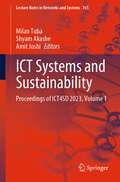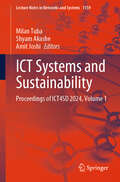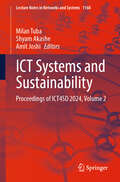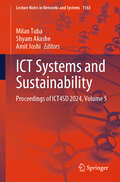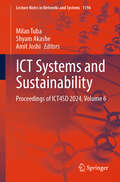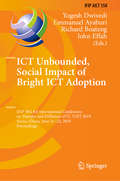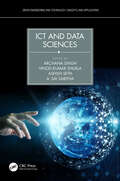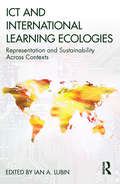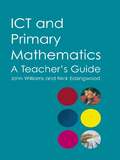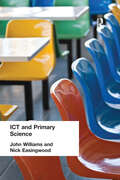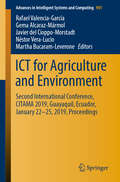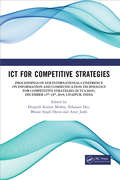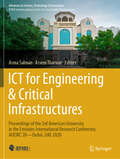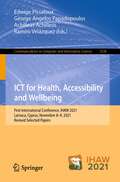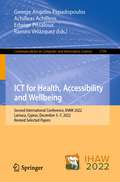- Table View
- List View
ICT Systems Security and Privacy Protection: 36th IFIP TC 11 International Conference, SEC 2021, Oslo, Norway, June 22–24, 2021, Proceedings (IFIP Advances in Information and Communication Technology #625)
by Lynn Futcher Audun Jøsang Janne HagenThis book constitutes the refereed proceedings of the 36th IFIP TC 11 International Conference on Information Security and Privacy Protection, SEC 2021, held in Oslo, Norway, in June 2021.*The 28 full papers presented were carefully reviewed and selected from 112 submissions. The papers present novel research on theoretical and practical aspects of security and privacy protection in ICT systems. They are organized in topical sections on digital signatures; vulnerability management; covert channels and cryptography; application and system security; privacy; network security; machine learning for security; and security management. *The conference was held virtually.
ICT Systems Security and Privacy Protection: 37th IFIP TC 11 International Conference, SEC 2022, Copenhagen, Denmark, June 13–15, 2022, Proceedings (IFIP Advances in Information and Communication Technology #648)
by Simone Fischer-Hübner Weizhi Meng Christian D. JensenThis book constitutes the refereed proceedings of the 37th IFIP TC 11 International Conference on Information Security and Privacy Protection, SEC 2022, held in Copenhagen, Denmark, in June 2022. The 29 full papers presented were carefully reviewed and selected from 127 submissions. The papers present novel research on theoretical and practical aspects of security and privacy protection in information processing systems. They are organized in topical sections on privacy models and preferences; network security and IDS; network security and privacy; forensics; trust and PETs; crypto-based solutions; usable security; blockchain; mobile security and privacy; PETs and crypto; and vulnerabilities.
ICT Systems Security and Privacy Protection: 38th IFIP TC 11 International Conference, SEC 2023, Poznan, Poland, June 14–16, 2023, Revised Selected Papers (IFIP Advances in Information and Communication Technology #679)
by Norbert Meyer Anna Grocholewska-CzuryłoThis book constitutes the refereed proceedings of the 38th IFIP TC 11 International Conference on Information Security and Privacy Protection, SEC 2023, held in Poznan, Poland, in June 2023. The 26 full papers included in this book were carefully reviewed and selected from 84 submissions. They focus on topics such as access control and authentication; applied cryptography; mobile security; side-channel attacks; trust management, digital forensics; industry networks security, etc.
ICT Systems Security and Privacy Protection: 39th IFIP International Conference, SEC 2024, Edinburgh, UK, June 12–14, 2024, Proceedings (IFIP Advances in Information and Communication Technology #710)
by Steven Furnell Sokratis Katsikas Konstantinos Markantonakis Nikolaos PitropakisThis book constitutes the proceedings of the 39th IFIP International Conference on ICT Systems Security and Privacy Protection, SEC 2024, held in Edinburgh, UK, during June 12–14, 2024. The 34 full papers presented were carefully reviewed and selected from 112 submissions. The conference focused on current and future IT Security and Privacy Challenges and also was a part of a series of well-established international conferences on Security and Privacy.
ICT Systems Security and Privacy Protection: 40th IFIP International Conference, SEC 2025, Maribor, Slovenia, May 21–23, 2025, Proceedings, Part I (IFIP Advances in Information and Communication Technology #745)
by Joaquin Garcia-Alfaro Tatjana Welzer Kai Rannenberg Lili Nemec ZlatolasThe two-volume set IFIP AICT 745 + 746 constitutes the refereed proceedings of the 40th IFIP International Conference on ICT Systems Security and Privacy Protection, SEC 2025, held in Maribor, Slovenia, during May 21-23, 2025. The 28 full papers and 7 workshop papers included in this book were carefully reviewed and selected from 127 submissions. They were organized in topical sections as follows: Privacy protection; Industrial and Critical Infrastructure Security; Applied Cryptography; Data and Application Security; and International Workshop on Network and Distributed Systems Security (WNDSS 2025).
ICT Systems Security and Privacy Protection: 40th IFIP International Conference, SEC 2025, Maribor, Slovenia, May 21–23, 2025, Proceedings, Part II (IFIP Advances in Information and Communication Technology #746)
by Joaquin Garcia-Alfaro Tatjana Welzer Kai Rannenberg Lili Nemec ZlatolasThe two-volume set IFIP AICT 745 + 746 constitutes the refereed proceedings of the 40th IFIP International Conference on ICT Systems Security and Privacy Protection, SEC 2025, held in Maribor, Slovenia, during May 21-23, 2025. The 28 full papers and 7 workshop papers included in this book were carefully reviewed and selected from 127 submissions. They were organized in topical sections as follows: Privacy protection; Industrial and Critical Infrastructure Security; Applied Cryptography; Data and Application Security; and International Workshop on Network and Distributed Systems Security (WNDSS 2025).
ICT Systems and Sustainability: Proceedings of ICT4SD 2019, Volume 1 (Advances in Intelligent Systems and Computing #1077)
by Amit Joshi Shyam Akashe Milan TubaThis book proposes new technologies and discusses future solutions for ICT design infrastructures, as reflected in high-quality papers presented at the 4th International Conference on ICT for Sustainable Development (ICT4SD 2019), held in Goa, India, on 5–6 July 2019. The conference provided a valuable forum for cutting-edge research discussions among pioneering researchers, scientists, industrial engineers, and students from all around the world. Bringing together experts from different countries, the book explores a range of central issues from an international perspective.
ICT Systems and Sustainability: Proceedings of ICT4SD 2020, Volume 1 (Advances in Intelligent Systems and Computing #1270)
by Amit Joshi Shyam Akashe Milan TubaThis book proposes new technologies and discusses future solutions for ICT design infrastructures, as reflected in high-quality papers presented at the 5th International Conference on ICT for Sustainable Development (ICT4SD 2020), held in Goa, India, on 23–24 July 2020. The conference provided a valuable forum for cutting-edge research discussions among pioneering researchers, scientists, industrial engineers, and students from all around the world. Bringing together experts from different countries, the book explores a range of central issues from an international perspective.
ICT Systems and Sustainability: Proceedings of ICT4SD 2021, Volume 1 (Lecture Notes in Networks and Systems #321)
by Amit Joshi Shyam Akashe Milan TubaThis book proposes new technologies and discusses future solutions for ICT design infrastructures, as reflected in high-quality papers presented at the 6th International Conference on ICT for Sustainable Development (ICT4SD 2021), held in Goa, India, on 5–6 August 2021. The book covers the topics such as big data and data mining, data fusion, IoT programming toolkits and frameworks, green communication systems and network, use of ICT in smart cities, sensor networks and embedded system, network and information security, wireless and optical networks, security, trust, and privacy, routing and control protocols, cognitive radio and networks, and natural language processing. Bringing together experts from different countries, the book explores a range of central issues from an international perspective.
ICT Systems and Sustainability: Proceedings of ICT4SD 2022 (Lecture Notes in Networks and Systems #516)
by Amit Joshi Shyam Akashe Milan TubaThis book proposes new technologies and discusses future solutions for ICT design infrastructures, as reflected in high-quality papers presented at the 7th International Conference on ICT for Sustainable Development (ICT4SD 2022), held in Goa, India, on 29–30 July 2022. The book covers the topics such as big data and data mining, data fusion, IoT programming toolkits and frameworks, green communication systems and network, use of ICT in smart cities, sensor networks and embedded system, network and information security, wireless and optical networks, security, trust, and privacy, routing and control protocols, cognitive radio and networks, and natural language processing. Bringing together experts from different countries, the book explores a range of central issues from an international perspective.
ICT Systems and Sustainability: Proceedings of ICT4SD 2023, Volume 1 (Lecture Notes in Networks and Systems #765)
by Amit Joshi Shyam Akashe Milan TubaThis book proposes new technologies and discusses future solutions for ICT design infrastructures, as reflected in high-quality papers presented at the 8th International Conference on ICT for Sustainable Development (ICT4SD 2023), held in Goa, India, on 3–4 August 2023. The book covers the topics such as big data and data mining, data fusion, IoT programming toolkits and frameworks, green communication systems and network, use of ICT in smart cities, sensor networks and embedded system, network and information security, wireless and optical networks, security, trust, and privacy, routing and control protocols, cognitive radio and networks, and natural language processing. Bringing together experts from different countries, the book explores a range of central issues from an international perspective.
ICT Systems and Sustainability: Proceedings of ICT4SD 2024, Volume 1 (Lecture Notes in Networks and Systems #1159)
by Amit Joshi Shyam Akashe Milan TubaThis book proposes new technologies and discusses future solutions for ICT design infrastructures, as reflected in high-quality papers presented at the 8th International Conference on ICT for Sustainable Development (ICT4SD 2024), held in Goa, India, on 8–9 August 2024. The book covers the topics such as big data and data mining, data fusion, IoT programming toolkits and frameworks, green communication systems and network, use of ICT in smart cities, sensor networks and embedded system, network and information security, wireless and optical networks, security, trust, and privacy, routing and control protocols, cognitive radio and networks, and natural language processing. Bringing together experts from different countries, the book explores a range of central issues from an international perspective.
ICT Systems and Sustainability: Proceedings of ICT4SD 2024, Volume 2 (Lecture Notes in Networks and Systems #1160)
by Amit Joshi Shyam Akashe Milan TubaThis book proposes new technologies and discusses future solutions for ICT design infrastructures, as reflected in high-quality papers presented at the 8th International Conference on ICT for Sustainable Development (ICT4SD 2024), held in Goa, India, on 8–9 August 2024. The book covers the topics such as big data and data mining, data fusion, IoT programming toolkits and frameworks, green communication systems and network, use of ICT in smart cities, sensor networks and embedded system, network and information security, wireless and optical networks, security, trust, and privacy, routing and control protocols, cognitive radio and networks, and natural language processing. Bringing together experts from different countries, the book explores a range of central issues from an international perspective.
ICT Systems and Sustainability: Proceedings of ICT4SD 2024, Volume 5 (Lecture Notes in Networks and Systems #1163)
by Amit Joshi Shyam Akashe Milan TubaThis book proposes new technologies and discusses future solutions for ICT design infrastructures, as reflected in high-quality papers presented at the 8th International Conference on ICT for Sustainable Development (ICT4SD 2024), held in Goa, India, on 8–9 August 2024. The book covers the topics such as big data and data mining, data fusion, IoT programming toolkits and frameworks, green communication systems and network, use of ICT in smart cities, sensor networks and embedded system, network and information security, wireless and optical networks, security, trust, and privacy, routing and control protocols, cognitive radio and networks, and natural language processing. Bringing together experts from different countries, the book explores a range of central issues from an international perspective.
ICT Systems and Sustainability: Proceedings of ICT4SD 2024, Volume 6 (Lecture Notes in Networks and Systems #1194)
by Amit Joshi Shyam Akashe Milan TubaThis book proposes new technologies and discusses future solutions for ICT design infrastructures, as reflected in high-quality papers presented at the 8th International Conference on ICT for Sustainable Development (ICT4SD 2024), held in Goa, India, on 8–9 August 2024. The book covers the topics such as big data and data mining, data fusion, IoT programming toolkits and frameworks, green communication systems and network, use of ICT in smart cities, sensor networks and embedded system, network and information security, wireless and optical networks, security, trust, and privacy, routing and control protocols, cognitive radio and networks, and natural language processing. Bringing together experts from different countries, the book explores a range of central issues from an international perspective.
ICT Unbounded, Social Impact of Bright ICT Adoption: IFIP WG 8.6 International Conference on Transfer and Diffusion of IT, TDIT 2019, Accra, Ghana, June 21–22, 2019, Proceedings (IFIP Advances in Information and Communication Technology #558)
by Yogesh Dwivedi Emmanuel Ayaburi Richard Boateng John EffahThis book constitutes the refereed proceedings of the IFIP WG 8.6 International Working Conference "ICT Unbounded, Social Impact of Bright ICT Adoption" on Transfer and Diffusion of IT, TDIT 2019, held in Accra, Ghana, in June 2019. The 30 revised full papers and 4 short papers presented were carefully reviewed and selected from 72 submissions. The papers focus on Bright Information and Communication Technology, a concept that entails the development of relevant technologies, business models, public policies, social norms, international agreements, metrics of measuring national progress and preventing undesirable activities on the Internet. They are organized in the following topical sections: technology adoption, diffusion and ubiquitous computing; big data and business intellligence; smart cities; and security, privacy, ethics and misinformation.
ICT and Data Sciences (Green Engineering and Technology)
by Archana Singh Ashish Seth Vinod Kumar Shukla A. Sai SabithaThis book highlights the state-of-the-art research on data usage, security, and privacy in the scenarios of the Internet of Things (IoT), along with related applications using Machine Learning and Big Data technologies to design and make efficient Internet-compatible IoT systems. ICT and Data Sciences brings together IoT and Machine Learning and provides the careful integration of both, along with many examples and case studies. It illustrates the merging of two technologies while presenting basic to high-level concepts covering different fields and domains such as the Hospitality and Tourism industry, Smart Clothing, Cyber Crime, Programming, Communications, Business Intelligence, all in the context of the Internet of Things. The book is written for researchers and practitioners, working in Information Communication Technology and Computer Science.
ICT and International Learning Ecologies: Representation and Sustainability Across Contexts
by Ian A. LubinICT and International Learning Ecologies addresses new ways to explore international, comparative, and cultural issues in education and technology. As today’s development orthodoxies push societies around the world to adopt imported information communication tools, new approaches are needed that integrate cultural responsiveness, autonomy, and sustainability into technology-enhanced learning. This edited collection conceptually and methodologically reframes the complexities of teaching and learning in historically marginalized communities around the world, where inequities are often exacerbated by one-size-fits-all programs. Graduate students and researchers of educational technology, international/comparative education, and sustainability education will be better prepared to lead information and communication technologies (ICT) implementation across a range of contexts and learner identities.
ICT and Primary Mathematics: A Teacher's Guide
by John Williams Nick EasingwoodThis book is for teachers who are looking for interesting and practical ways to incorporate ICT into their daily lesson plans. It shows how ICT can be used as a tool for mathematics, but more importantly how its proper use can enhance the mathematics being taught. The authors cover all current aspects of ICT and mathematics, including: databases spreadsheets logo and the use of floor turtles and control technology handling of resources including interactive whiteboards management of ICT within the classroom how ICT can be used to present mathematical topics and links to other areas of the curriculum. With plenty of suggestions on how to use the software and hardware described in the book, this is a useful resource for all primary teachers, particularly subject co-ordinators for ICT and mathematics. It will also be of interest to students on PGCE and Initial Teacher Training courses.
ICT and Primary Science
by John Williams Nick EasingwoodThroughout this book, the authors emphasize that primary science is at its best as a practical, hands-on experience for children. When ICT is used in an integral way, it can enable practical work to be done at a more sophisticated level, helping children to make sense of their findings. The book includes several case studies from primary classrooms and each chapter includes practical suggestions for teachers. The wide-ranging topics covered include: databases and spreadsheets data logging control technology ICT, drama and science school visits planning for ICT and science choosing and using software. ICT and Primary Science is an accessible and jargon-free resource for teachers and student teachers of primary science.
ICT for Agriculture and Environment: Second International Conference, CITAMA 2019, Guayaquil, Ecuador, January 22-25, 2019, Proceedings (Advances in Intelligent Systems and Computing #901)
by Rafael Valencia-García Gema Alcaraz-Mármol Néstor Vera-Lucio Martha Bucaram-Leverone Javier del Cioppo-MorstadtThis book offers a remarkable collection of chapters covering a wide range of topics related to ICT applications in agriculture and the environment. It gathers the proceedings of the 2nd International Conference on ICTs in Agronomy and Environment (CITAMA 2019), held in Guayaquil, Ecuador on January 22–25, 2019. The conference attracted a total of 27 papers, submitted by pioneering researchers from countries around the globe. Following a thorough peer-review by leading experts, only 14 papers were ultimately selected for publication. They cover a diverse range of topics, including: intelligent and knowledge-based systems; the Internet of things and monitoring systems; image processing; and social and collaborative systems. The book offers a valuable resource for a broad readership, including researchers, educators, undergraduate and graduate students, as well as professionals from the areas of ICT, Agriculture and Environment.
ICT for Competitive Strategies: Proceedings of 4th International Conference on Information and Communication Technology for Competitive Strategies (ICTCS 2019), December 13th-14th, 2019, Udaipur, India (Conference Proceedings Series on Information and Communications Technology)
by Durgesh Kumar Mishra; Nilanjan Dey; Bharat Singh Deora; Amit JoshiFourth International Conference on Information and Communication Technology for Competitive Strategies targets state-of-the-art as well as emerging topics pertaining to information and communication technologies (ICTs) and effective strategies for its implementation for engineering and intelligent applications.
ICT for Engineering & Critical Infrastructures: Proceedings of the 3rd American University in the Emirates International Research Conference, AUEIRC'20—Dubai, UAE 2020 (Advances in Science, Technology & Innovation)
by Asma Salman Assem TharwatThis book—consisting of four parts—brings forth a comprehensive evaluation of information and communication technologies (ICTs) utilization in engineering and infrastructures. The field of engineering has consistently been a bastion of problem-solving and innovation. It has continuously aided humanity in conquering seemingly unsolvable obstacles by pushing the limits of human capability and ingenuity. In the modern age, modern computational methods and digital systems present themselves as the frontier of novel technological innovation, thus attaining the potential to considerably strengthen various engineering fields. Tackling essential topics such as the incorporation of informatics in infrastructure, cybersecurity, advanced networking techniques, and smart resource management, this book peers into the future of engineering, proving as an excellent resource for engineers, entrepreneurs, policymakers, network specialists, and finally, computer scientists.
ICT for Health, Accessibility and Wellbeing: First International Conference, IHAW 2021, Larnaca, Cyprus, November 8–9, 2021, Revised Selected Papers (Communications in Computer and Information Science #1538)
by George Angelos Papadopoulos Edwige Pissaloux Achilleas Achilleos Ramiro VelázquezThis book constitutes selected papers presented at the First International Conference on ICT for Health, Accessibility and Wellbeing, IHAW 2021, held in Larnaca, Cyprus, in November 2021. The 12 full papers and 7 short papers were thoroughly reviewed and selected from 36 submissions. One invited paper was also included in this volume. The papers are organized in topical sections on active aging; assistive devices and systems; brain functions support and mHealth; brain functions support and oncology; ICT and wellbeing.
ICT for Health, Accessibility and Wellbeing: Second International Conference, IHAW 2022, Larnaca, Cyprus, December 5–7, 2022, Revised Selected Papers (Communications in Computer and Information Science #1799)
by George Angelos Papadopoulos Edwige Pissaloux Achilleas Achilleos Ramiro VelázquezThis book constitutes the refereed post-conference proceedings of the Second International Conference on ICT for Health, Accessibility and Wellbeing, IHAW 2022, held in Larnaca, Cyprus, in December 2022. The revised 14 full papers and 3 short papers presented were carefully selected from 33 submissions. The papers are thematically arranged in the following sections: Visual Impairment and ICT for Mobility; ICT and Student Health; ICT and Wellbeing and ICT & Health prevention
